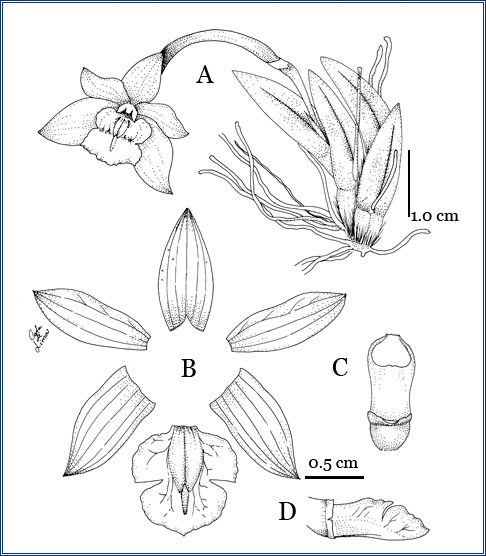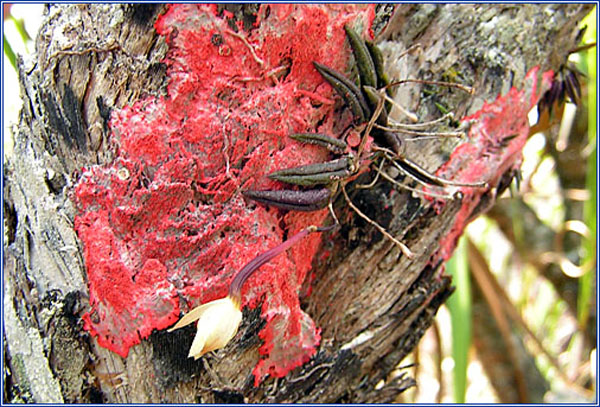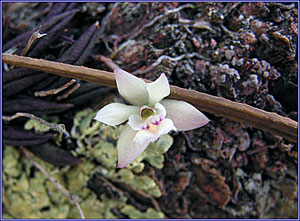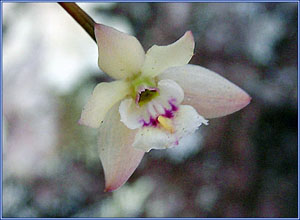|
LEPTOTES
VELLOZICOLA: A RECENT DISCRIBED SPECIES
OF
ORCHIDACEAE FROM BAHIA, BRAZIL Neodiver. 1:1-5 C.
VAN DEN BERG1, E. C. SMIDT1 AND
S. MARÇAL2
1Laboratório
de Sistemática Molecular de Plantas, Universidade
Estadual de Feira de Santana, BR 116, Km 3, 44031-460, Feira de Santana, Bahia, Brazil 2Rua Aníbal Bittencourt, 345, 45615-000, Buerarema, Bahia, Brazil |
abstract
A
recent discovered species of Leptotes from
Bahia, Leptotes vellozicolla Van den Berg,
E.C.Smidt & Marçal, is described and
illustrated. It is known only from the Chapada Diamantina,
Bahia, Brazil, growing epiphytically on Vellozia
sp. (Velloziaceae).
The genus Leptotes was originally described by Lindley (1853), who coined the name from the greek leptos, meaning tender or narrow, based on the thin appearance of the floral parts and leaves. In the original concept the genus was characterized by epiphytic, small, caespitose plants, inconspicous cylindric rhizomes, unifoliate pseudobulbs smaller than the cylindric, fleshy, canaliculate leaves. The inflorescence is a small 1-5-flowered raceme, with large flowers in relation to the plants, and narrow, similar petals and sepals, and a 3-lobed lip. The pollinaria is rather unique in Laeliinae, with 3 pairs of pollinia, being one large and two small. Such a pollinarium morphology is found only in the monotypic genus Loefgrenianthus, whose only species was originally described as a Leptotes. Molecular data (van den Berg et al. 2000) showed that Loefgrenianthus is sister to a group with all species of Leptotes, and could possibly be included in the latter, as originally described by Löfgren (1918). Bentham (1881) synonymized Leptotes under Tetramicra, despite the fact that the latter bears two pairs of pollinia. Cogniaux (1902) reestablished Leptotes, and listed then five species and three varieties. The first standalone revision of the genus was published by Krackowizer (1954a,b), in which he listed eleven species, occurring from Espírito Santo to Rio Grande do Sul States in Brazil, and extending to eastern Paraguay. However, in the classic checklist of the Brazilian orchids included in Pabst & Dungs (1975), they accepted only three species, and four synonyms. Withner (1993) accepted five species, but omitted the other six validly published names in the genus, leaving unclear whether he considered them synonyms or obscure species. According to a molecular phylogenetic analysis based on data from ITS DNA sequences (van den Berg et al. 2000), Leptotes belongs to a basal clade in Laeliinae, which includes Constantia, Isabelia, and Pseudolaelia. This clade comprises several genera which are native to Eastern and Southern Brazil, and are generally small plants, mainly growing on Velloziaceae or rocks, or small trees, associated mainly with the “campos rupestres” vegetation. The new genus Adamantinia also belongs to this clade (van den Berg, unpublished molecular data). Unlike other members of this clade, Leptotes occurs mainly in wet areas in the Atlantic Forest domain. Pabst & Dungs (1975) listed only L. bicolor Lindl. for Bahia State. Recently, two new species were described, L. bonhkiana Campacci (Campacci 2005) and L.pohlitinocoi V.P.Castro & Chiron (Castro Neto & Chiron 2004). Both new species occur in the Atlantic Rainforest near the shore in Southern Bahia. They present very similar floral morphology but striking size differences in vegetative and floral parts, being probably related to L. unicolor Barb.Rodr. In recent field work in the central portion of the State, we found another new species, that appears more related to L. pauloensis Hoehne than to the two new coastal species. It occurs in the Chapada Diamantina region, which is known for possessing a very particular and diverse flora, and which has been revealing many new species (e.g. Smidt & Toscano de Brito 2004) and even new genera, such as Adamantinia (van den Berg & Gonçalves 2004). Leptotes vellozicola Van den Berg, E.C.Smidt & Marçal, Neodiver. 1:1-5 Type BRAZIL. Bahia: Chapada Diamantina, 30 Oct 2005, E.C. Smidt, C. van den Berg, & S. Marçal 650 (Holotype: HUEFS!). Figs. 1, 2. Haec species L. tenui et praesertim L. pauloensi similis propter labelli cum lobis latis et lobo terminali bilobato fimbriis brevissimis instructo, sed ab ambobus speciebus labello cum lamellis latis basalibus et callo conspicuo in apicem differt. Epiphytic, caespitose herb, 2-3 cm high. Rhizome rather short, inconspicuous. Pseudobulbs cyllindric, 3-5 × 3-4 mm, 1leaved, vinaceous, covered by papery sheaths. Leaf cylindric, 15-20 × c. 4 mm, fleshy, canaliculate, vinaceous, leaf surface verrucose, apex acuminate. Inflorescence a 1-flowered raceme, c. 2 cm long. Flowers light lavender to white, lip with pinkish dash in the mid portion between the lateral lobes, and apex with a yellow callus, sepals lanceolate, c. 9 × 4 mm, lateral sepal free, slightly falciform, petals linear-lanceolate, c. 8 × 3 mm, lip trilobed, c. 7 × 7 mm, lateral lobes triangular, obtuse, c. 7 mm diam., midlobe lanceolate-ovate, c. 5 mm diam., disk 2-lamellate in the base, lamellae lanceolate, c. 4 mm., white, basally thickened, convergent, apex acute; apical callus linear, c. 1.5 mm long, yellow, column c. 2 mm long; stigma broad, entire. Fruit purplish vinaceous, lanceolate, c. 3 cm long. ETYMOLOGY: Named in reference to Vellozia sp., on which this species grows in the natural habitat. PARATYPES: BRAZIL, Bahia: Chapada Diamantina, 30 OCT 2005 (in fruit). E.C. Smidt, C. van den Berg & S. Marçal 652 (HUEFS). DISTRIBUTION: Known only from a single location in the Chapada Diamantina. HABITAT: Epiphyte on shaded positions on Vellozia sp. stems, in a rather open scrubland on rocky outcrops. COMMENTS:
Leptotes vellozicolla grows exclusively
on Velloziaceae, in the "campos rupestres"
vegetation, at ca. 900 m above sea level. Flower
morphology is similar to L. tenuis Rchb.f.
and L. pauloensis, considering the shape
of the lip with broad lateral lobes, and a terminal
lobe bilobed with a shortly fimbriate apex. However,
it can be differentiated from both by the two
basal lamellae and a callus in the lip apex. Leptotes
pauloensis has pink flowers, and lateral lobes
narrower than the midlobe, narrow basal lamellae
and does not bear a callus in the lip apex, whereas
L. tenuis bears whitish-cream flower with
a purple zone near the base, short, narrow lammellae
and callus absent. This species is the only in
the genus known to grow on Vellozia sp.,
which in itself is a very interesting link, considering
that this pattern is very similar to that of Constantia
and Pseudolaelia. Th is might
suggest that this species is a rather relictual,
basal species in the genus, in addition to L.
blancheamesiae Loefgr. The fimbriate bilobed
lip also suggests a relationship among the latter,
the new species, L. pauloensis and L.
tenuis. The species phylogeny within Leptotes
needs to be reevaluated to examine in detail these
hypotheses. The exact locality is not revealed
for protecting the species from illegal collection,
since the only population known is not in a protected
area. CONSERVATION STATUS: Vulnerable (IUCN criterion
Vu D2). Leptotes vellozicola has been found
so far in the Southern portion of the Chapada
Diamantina, in a restricted area that justifies
the criterion D2 of the IUCN. The area is subject
to frequent fires, at the same time that the destruction
of the species of Vellozia in which this
species grow are a clear threat to the only population
known. |
 |
Fig.
1. Leptotes vellozicolla Van den Berg,
E.C.Smidt & Marçal. |
 |
  |
Fig
2. Leptotes vellozicolla Van den Berg,
E.C.Smidt & Marçal. |
LITERATURE
CITED 1) Bentham, G. 1881. Notes on orchideae. Journal of the Linnaean Society, Botany 18:281-360. Campacci, M. 2005. Leptotes bohnkiana 2) Campacci. Boletim CAOB 53:18-20. Castro Neto, V.P. & Chiron, G.R. 2004. 3) Contribution à la conaissance des orchidées du Brésil. I. Une nouvelle espèce de Maxillaria de Espirito Santo. II. Une nouvelle espèce de Leptotes de Bahia. Richardiana 4:73-82. 4) Cogniaux, A. 1902. Leptotes. In: Martius, C.F. Flora Brasiliensis 3 (5):254-259. 5) Krackowizer, F.J. 1954. Monografia do gênero Leptotes. Parte I. Revista do Círculo Paulista de Orquidófilos 11:43-53. 6) Krackowizer, F.J. 1954. Monografia do gênero Leptotes. Parte II. Revista do Círculo Paulista de Orquidófilos 11:64-72. 7) Lindley, J. 1853. Folia Orchidacea: Leptotes. 3rd. Ed. Bradbury & Evans, London. 8) Löfgren, A. 1918. Contribuições para a flora Orchidacea. Archivos do Jardim Botânico do Rio de Janeiro 2:49-62. 9) Pabst, G.F.J. & Dungs, F. 1975. Orchidaceae Brasiliensis Vol. I. Brücke-Verlag Kurt Schmersow, Hildesheim, Germany. 10) Smidt, E.C. & Toscano de Brito, A.L.V. 2004. A new species of Sarcoglottis (Orchidaceae -Spiranthinae), from the Chapada Diamantina, Bahia, Brazil. Kew Bulletin 59:4-7 11) Van den Berg, C. & Gonçalves, C.N. 2004. Adamantinia, a showy new genus of Laeliinae from Eastern Brazil. Orchid Digest 68:230 232. 12) Van den Berg, C.; Higgins, W.E.; Dressler, R.L.; Whitten, W.M.; Soto Arenas, M.A.; Culham, A.; Chase, M.W. 2000. A phylogenetic analysis of Laeliinae (Orchidaceae) based on sequence data from Internal Transcribed Spacers (ITS) of nuclear ribosomal DNA. Lindleyana 15:96 114. 13) Whithner, C.L. 1993. The Cattleyas and their Relatives. Vol.III. Timber Press, Portland, Oregon. |
Photos: by the authors
| Any
kind of reproduction (print, digital or anyone) of any type of material
of this site: texts, layout, photos, images and others - is strictly forbidden without previous written permission of the authors. All rights reserved. Any solicitation or information by the e-mail: bo@sergioaraujo.com |